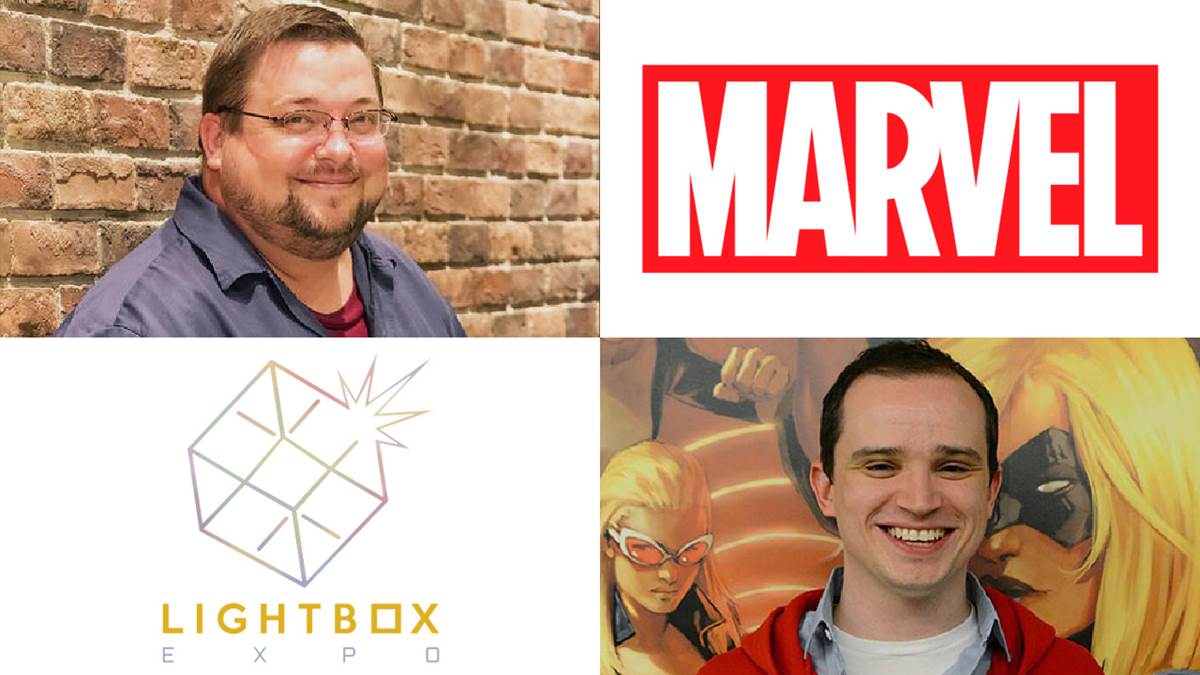Lightbox Expo may be an animation industry convention, but with so many talented young artists in attendance, Marvel Comics stopped by for their first presentation at the expo. Focused on new entrants to the comic book industry, Editor in Chief C.B. Cebulski announced that they’ve never given this presentation before. C.B. was joined by Marvel Comics Talent Scout Rickey Purdin for a panel called “Marvel Comics: More Than Just the Marvel Way,” which looked at the different disciplines in the comic book industry, both inside a comic’s pages and its eye-catching cover.
After a brief overview of the early days at the Marvel Bullpen under the leadership of Stan Lee and Jack Kirby, creators of “The Marvel Way” of creating comics, C.B. and Ricky gave attendees a more modern look at how comics are made. The average Marvel comic has six individual contributors, with C.B. acting as an honorary seventh member as Editor in Chief.
The process starts with a writer, who drafts the story like a screenplay. The writer describes all of the action, makes panel layout suggestions, and writes the dialogue. A penciler takes the script and creates a general outline of the comic, which can then be reviewed and revised. After that’s done, an Inker comes in and finalizes the lines, adding details and fleshing out the backgrounds. There are some cases where the penciler and inker are the same people, but these are often two separate artists. The fourth contributor colors the pages and the fifth, an often overlooked contributor, is the lettering artist. Last but not least comes the cover artist. As an example of all of these disciplines, C.B. and Rickey shared the progression of a single page from the recent Amazing Spider-Man #1 written by Zeb Wells, penciled by John Romita Jr., inked by Scott Hanna, colored by Marcio Menyz, lettered by VC’s Joe Caramagna, and with a general release cover by John Romita Jr., plus a wide array of variant covers by Romy Jones, Alan Davis, Travis Charest, Mark Bagley, Peach Momoko, Artgerm Lau, Jim Cheung, Humberto Ramos, Patrick Gleason, Skottie Young, Bengal, and In-Hyuk Lee.
Talking through workload expectations, the average writer, penciler, and inker can create ten comics per year. John Romita Jr, for example, pencils an average of one page per day and a typical comic book is twenty pages. There are exceptions to the rule, like Jack Kirby, who could produce multiple comic books every month, and Japanese artist Peach Momoko, who does her own writing, penciling, inking, and coloring at record speeds. Peach was used as another example of the process of making a comic book with progressions from Demon Wars: Shield of Justice #1, which also showcased some key differences between creating a Japanese manga and an American comic book.
C.B. Cebulski has final approval of all Marvel Comics covers, sharing that while all of the artists are still working from home, one of his favorite parts of Marvel HQ is a cover wall that they swap out with all of the latest releases to help make sure that each comic stands out on its own. Cover artists are often hired for one-off assignments and are tasked with submitting an average of two-to-four sketches for variety. Marco Checchetto’s work on Silver Surfer was used to demonstrate how the cover changed from the preliminary sketch to the final design. Featuring the character on an iconic flight through space, something as simple as the moons around a planet in the background needed to be rearranged before going to final ink and color. The conversation also included the typical layout of a cover, leaving negative space in specific spots for the book’s title, issue number, and any other messages that may be added in an effort to help sell the book on a shelf.
With so much of the comic industry having gone digital, there was also a lot of conversation about variant covers. From appealing to a wider range of collectors and retailers to changing the approach of how a cover gets your attention on a digital platform like Comixology, it offered an interesting look at how the comic industry is ever-changing. There was also a brief discussion about the newer format of Marvel Infinity Comics, which are read vertically and break the traditional comic frame. Many legacy comic artists find this medium difficult to draw, whereas artists with an animation background tend to do better, opening doors for different types of audiences for work for Marvel Comics. Another benefit of the digital process is that all of the contributors to a comic book don’t need to live near each other, or even in the same country. It’s truly a global effort.
Artist Devin Grayson once said that getting into Marvel Comics was “like breaking out of jail.” Rickey shared that he has tried to streamline the system, but getting a foot in the door is still a challenge. For any aspiring comics artists, Marvel Comics does send out sample scripts so that they can show their skills at penciling, inking, coloring, or all three disciplines. As an occasional comic reader, this presentation was an eye-opening look at the current state of the comic book industry. The panel was so successful that C.B. and Rickey ran over on time, graciously offering to meet with attendees in the hallway afterward to answer any remaining questions. Their passion and generosity for the comic book industry certainly rubbed off on everyone and made a lot of aspiring artists consider lending their talents to the world of Marvel Comics.
Visit LightBoxExpo.com to learn more about the annual event held in Pasadena and how you can attend next year.
(Please note this article contains affiliate links. Your purchase will support LaughingPlace by providing us a small commission, but will not affect your pricing or user experience. Thank you.)

